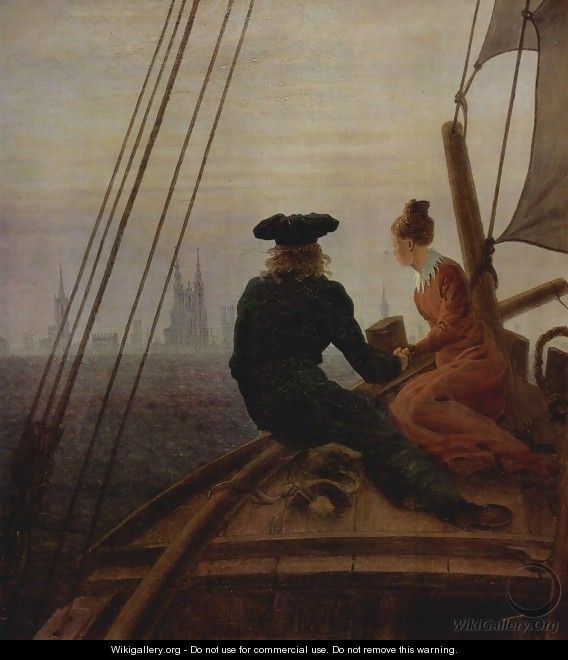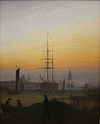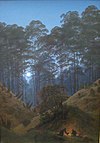迷失畫廊
逛畫廊,看世界, 記下自己的心得Wanderer above the Sea of Fog (1818). Kunsthalle Hamburg.
This well-known and especially Romantic masterpiece was described by the writer John Lewis Gaddis as leaving a contradictory impression, "suggesting at once mastery over a landscape and the insignificance of the individual within it. We see no face, so it's impossible to know whether the prospect facing the young man is exhilarating, or terrifying, or both."
第一次見這幅畫,是在德國男高音Jonas Kaufmann的CD封麵看到的,很是被衝擊,尤其是看到在洶湧的大海上,一位手持拐丈孤獨的紳士站在海邊岩石上的背影,反差對比很大:人與自然,渺小與博大, 大海的正麵和人的背麵,克製理智和浪漫激情, 給人很多想象空間...之後一直很想知道誰是畫得作者, 但感覺告訴我,作者可能是一位德國或北歐的畫家,色彩,著裝,舉止,浪漫卻有點壓抑
卡斯帕·大衛·弗裏德裏希(Caspar David Friedrich 1774-1840).德國偉大的浪漫主義畫家,1774年9月5日出生於德國格雷夫斯瓦德港市,早年在哥本哈根美術學院學習,後來定居德累斯頓。那裏他過著平靜的活,有時會去波西米亞的山區和湖泊旅行。性格憂傷而內省,喜歡依靠己的沉思來喚起創作的靈感。曾說:“當你閉上肉體的眼睛,你就第一次能夠用心靈眼睛觀察你的繪畫。”他一開始用鉛筆繪製風景,直到1807年才進行油畫創作。他的題材開辟了風景繪畫新的領域,發現了人們從未發現的新的自然:無窮無盡的海洋或山脈、大雪覆蓋的山地,以及照在上麵的陽光或月光。他很少用宗教形象,但是風景畫傳達了崇高的精神力量。19世紀晚期隨著象征主義的興起,他的藝術受到人們高度評價.
他的風景畫在今天是浪漫主義的代名詞. 對於他來說, 關鍵的不是機械地模寫, 而是自由地創作, 通過"顏色和造型表達出言語所不能表達的東西." 弗裏德裏希生活在在19世紀被成為"浪漫主義的郊區"的德雷斯頓. 作家諾瓦利斯, 讓.保爾和史雷格爾兄弟和他保持著友好的關係. 在他死後百年, 他的風景畫才獲得廣泛的認同. 在國內外舉行的他的作品的回顧展在今天是被參觀地最多的展覽.
弗裏德裏希早年衣食無憂,尤其在法國大革命和拿破侖戰爭時期,由於貿易受阻,當地的肥皂價格飛漲,別人家生活受到影響,而弗裏德裏希家卻收入頗佳。當時正值他求學從藝時期,完全沒有受到生活窘迫的幹擾,本應該在藝術中表現出歡娛情跡,然而,事實是早在他7歲母親去世開始 ,就接二連三地遭受人生不幸。母親去世後1年多姐姐伊麗莎白也隨之去世,5年後哥哥克裏斯多夫又在一次滑雪運動中喪生,直接原因是哥哥為了救助即將淹死的弗裏德裏希送命的。
1791年他的另一個姐姐又不幸去世,這一係列生活悲劇在他心靈中烙下濃重陰影,並對他後來的藝術創作產生了深刻影響。或許,他作品中對大自然的崇拜之餘,對人麵對自然時的渺小、無奈的悲觀情緒就是來源於此吧
另外,弗裏德裏希家庭信仰新教,是虔誠派信徒,講求自我內視,他也受家庭影響,早在十五六歲時就在文章中表述過社會教化的內容。這種影響體現在他的畫中的神秘的宗教氣息,而這股宗教氣息在《海邊修士》中尤為突出。
弗裏德裏希20歲時到哥本哈根藝術學院求學,深受尼古萊 •阿伯拉 •阿比爾德加教授影響,奠定了沉靜憂思的藝術情調。1798年春天,他遷居到德雷斯頓。德雷斯頓雖然不是非常繁華,當沿著易北河流域有優美的風景區,因為這裏有一所藝術學院吸引著藝術家來到這裏,所以有較濃的藝術氣氛。從這時起到1808年是弗裏德裏希繪畫風格的形成階段,他在1801年展出的波西米亞祭壇板油畫《山上的十字架》標誌著他的風格已經成熟,他基本上告別了單色畫,領略到了色彩與光的魅力。
他常利用自己對自然景物勾畫出的素描,進行高度個人化的演繹。他的畫粗略看去似乎平常無奇,但仔細審視就會發現極豐富的奇特內涵。他的藝術思想是與德國的民族情感和宗教相連的。這段時期正值拿破侖於德國戰爭,雖然他的作品色彩豐富,但並不是快樂風格,而是悲觀憂鬱的。他認為地理環境對某個民族性格的形成非常重要,自然條件也會影響人的文化特質,每個地區自然環境不同,人們的氣息也不會相同,每個民族隻適合在自己的土地上生存。因此,他一生中的不間斷旅行寫生都是在德國,尤其多在中部和北部,因為他的故鄉就在這裏。他與布萊克有相同之處,他們都帶有濃厚的唯心思想,然而又都有濃厚的民族情感和人道精神,是他們作品中的精髓所在。
1810 年開始是弗裏德裏希的黃金時期 。這一年 ,他在柏林美術學院展出了《海邊修士》和 《橡樹林的修道院》,畫麵濃鬱的陰沉憂鬱氣息震動了觀眾。這兩幅畫是他的藝術進一步成熟的標誌,也是感情基調據許沉降的顯示。1816年,德雷斯頓藝術學院把他選為學院院士,標誌著他的藝術得到了承認,他多年懸浮不定的心終於穩定下來,也開始賣出畫作了。1818年,他與克裏斯蒂安•卡洛琳•邦梅爾結婚,從此,他的畫中多了一分溫馨。
1810-1834 年是弗裏德裏希的黃金時期,到了1835年,他中風癱瘓,再也沒有畫油畫,而是一些小幅的墨水壁畫 。這些畫的內容更直接描繪死亡與永恒的話題,如烏鴉、貓頭鷹、墳場、棺材、十字架等。 1840年5月7日,弗裏德裏希在德雷斯頓去世。弗裏德裏希的代表作有1808年完成的標誌他繪畫風格成熟的 《山上的十字架》,1810年展出的 《橡樹林裏的修道院》和《海邊修士》,1815年完成的《雲海中的旅行者》,1818-1819年,也就是在婚後完成的《在帆船上》,1821-1822年的《海邊看月出》,他表現永恒精神時期最有代表性的一幅是1824年的《北極冰海遇難船》.
作為一個藝術家,他的主要興趣是寄情自然,他往往通過象征性和反傳統的工作來傳達對自然世界一種主觀情感化的反應。1920年代,他的畫作被表現主義者重新發掘。在1930年代和1940年代初超現實主義者和存在主義者經常從他的畫中汲取靈感。(百度)
Loneliness and death
Both Friedrich's life and art are marked with an overwhelming sense of loneliness. This becomes more apparent in his later works, from a time when friends, members of his family and fellow pioneers of early romanticism began to either become distant from him or die.
Art historians and some of his contemporaries attribute the melancholy in his art to the losses suffered during his youth to the bleak outlook of his adulthood, while Friedrich's pale and withdrawn appearance helped reinforce the popular notion of the "taciturn man from the North".[
Friedrich suffered depressive episodes in 1799, 1803–1805, c.1813, in 1816 and between 1824 and 1826. There are noticeable thematic shifts in the works he produced during these episodes, which see the emergence of such motifs and death symbols as vultures, owls, graveyards and ruins.From 1826 these motifs became a permanent feature of his output, while his use of color became more dark and muted. Carus wrote in 1929 that Friedrich "is surrounded by a thick, gloomy cloud of spiritual uncertainty", while in 2004 the psychiatrist Carsten Spitzer wrote that he believed during his life, Friedrich suffered prolonged inertia, a suicide attempt and what the artist himself described as a "dreadful weariness".[
Chalk Cliffs on Rügen, (1818). Museum Oskar Reinhart am Stadtgarten, Winterthur, Switzerland.
Friedrich married Christiane Caroline Bommer in 1818, and on their honeymoon they visited relatives in Neubrandenburg and Greifswald. This painting celebrates the couple's union

Man and Woman Contemplating the Moon (1830–35). 34 × 44 cm. Alte Nationalgalerie, Berlin.
In this work, the artist depicts a couple gazing longingly at nature, in "Old German" clothes, "scarcely different in tone or modelling from the deep dramas of nature around them".
The Cross Beside The Baltic (1815), 45 × 33.5 cm. Schloss Charlottenburg, Berlin.
This painting marked a move away by Friedrich from depictions in broad daylight, and a return to nocturnal scenes, twilight and a deeper poignancy of mood.
Moonrise Over the Sea (1822). 55 × 71 cm. Alte Nationalgalerie, Berlin.
During the early 1820s, human figures appear with increasing frequency in the paintings. Of this period, Linda Siegel writes, "the importance of human life, particularly his family, now occupies his thoughts more and more, and his friends appear as frequent subjects in his art."[
Seashore by Moonlight (1835–36). 134 × 169 cm. Kunsthalle, Hamburg.
His final "black painting", Seashore by Moonlight, is described by William Vaughan as the "darkest of all his shorelines."

Frau am Fenster Berlin, Alte Nationalgalerie, Inv. Nr. A I 918
Auf dem Segler
Graveyard under Snow (1826). 31 × 25 cm. Museum der bildenden Künste, Leipzig.
Friedrich sketched memorial monuments and sculptures for mausoleums, reflecting his obsession with death and the afterlife. He also created some of the funerary art in Dresden's cemeteries
Work
Friedrich was a prolific artist who produced more than 500 attributed works.[87] In line with the Romantic ideals of his time, he intended his paintings to function as pure aesthetic statements, so he was cautious that the titles given to his work were not overly descriptive or evocative. It is likely that some of today's more literal titles, such as "The Stages of Life", were not given by the artist himself, but were instead adopted during one of the revivals of interest in Friedrich.[88] Complications arise when dating Friedrich's work, in part because he often did not directly name or date his canvases. He kept a carefully detailed notebook on his output, however, which has been used by scholars to tie paintings to their completion dates
Bild | Titel | Jahr | Größe / Material | Ausstellung/Sammlung/Besitzer |
|---|---|---|---|---|
 | Wrack im Eismeer | 1798 | 31,4 x 23,6 cm, Öl auf Leinwand | Hamburg, Kunsthalle (Zuschreibung an Friedrich wird angezweifelt) |
 | Blick auf Arkona mit aufgehendem Mond und Netzen | 1803 | Privatbesitz von Jan Krugier | |
 | Westfassade der Ruine Eldena mit Backhaus und Scheune | 1806 | Angers, Musée des Beaux-Arts | |
 | Der Sommer | 1807 | 71,4 x 103,6 cm, Öl auf Leinwand | München, Neue Pinakothek |
 | Hünengrab im Schnee | 1807 | 62 × 80 cm, Öl auf Leinwand | Dresden, Galerie Neue Meister |
 | Meeresstrand im Nebel | um 1807 | 34,2 x 50,2 cm, Öl auf Leinwand | Wien, Österreichische Galerie, Inv. Nr. 3700 |
 | Meeresstrand mit Fischer | um 1807 | 34,5 x 51 cm, Öl auf Leinwand | Wien, Österreichische Galerie, Inv. Nr. 3701 |
 | Ausblick ins Elbtal | um 1807 | 81,5 x 80 cm, Öl auf Leinwand | Dresden, Galerie Neue Meister |
 | Das Kreuz im Gebirge (Tetschener Altar) | 1808 | 115 x 110,5 cm, Öl auf Leinwand | Dresden, Galerie Neue Meister |
 | Morgennebel im Gebirge | 1808 | 71 x 104 cm, Öl auf Leinwand | Rudolstadt, Museum Schloss Heidecksburg |
 | Winter (Klosterruine Eldena) | 1808 | 1931 im Münchner Glaspalast verbrannt | |
 | Der Mönch am Meer | 1809/10 | 110 x 171,5 cm, Öl auf Leinwand | Berlin, Alte Nationalgalerie |
 | Abtei im Eichwald | 1809/10 | 110,4 x 171 cm, Öl auf Leinwand | Berlin, Alte Nationalgalerie |
 | Gebirgslandschaft mit Regenbogen | 1810 | 70 x 102 cm, Öl auf Leinwand | Essen, Museum Folkwang |
 | Böhmische Landschaft mit dem Milleschauer | um 1810 | 71 x 104 cm, Öl auf Leinwand | Dresden, Galerie Neue Meister |
 | Landschaft mit Regenbogen | um 1810 | 59 x 84,5 cm, Öl auf Leinwand | seit 1945 verschollen |
 | Felspartie | 1811 | 32 x 45 cm | Dresden, Galerie Neue Meister |
 | Winterlandschaft | 1811 | 32,5 x 45 cm, Öl auf Leinwand | Schwerin, Staatliches Museum[6] |
 | Winterlandschaft mit Kirche | 1811 | Dortmund, Museum für Kunst und Kulturgeschichte | |
 | Kreuz und Kathedrale im Gebirge | 1812 | 45 x 38,5 cm, Öl auf Leinwand | Düsseldorf, Kunstmuseum |
 | Gräber gefallener Freiheitskrieger | 1812 | 49.5 × 70.5 cm, Öl auf Leinwand | Hamburg, Kunsthalle |
 | Kreuz im Wald | 1813 | 42 x 32 cm, Öl auf Leinwand | Stuttgart, Staatsgalerie, Inv. Nr. L 569 |
 | Kreuz an der Ostsee | 1813 ?? | 45 x 33,5 cm, Öl auf Leinwand | Berlin, Schloss Charlottenburg |
 | Der Chasseur im Walde | 1814 | 65,7 x 46,7 cm, Öl auf Leinwand | Privatbesitz |
 | Morgen (Ausfahrende Boote) Teil eines heute verstreuten vierteiligen Zyklus | nach 1815 | Niedersächsisches Landesmuseum, Hannover | |
 | Neubrandenburg | 1816/1817 | 91 x 72 cm, Öl auf Leinwand | Greifswald, Pommersches Landesmuseum[7] |
 | Greifswald im Mondschein | 1816/17 | 22,5 x 30,5 cm | Oslo, Norwegen, Nationalgalerie |
| Küstenlandschaft in der Dämmerung | 1816–18 | 22 x 31 cm, Öl auf Leinwand | Lübeck, Museum für Kunst und Kulturgeschichte, Inv. Nr. 1950/5 | |
 | Der Wanderer über dem Nebelmeer | wohl 1817 | 98,4 x 74,8 cm, Öl auf Leinwand | Hamburg, Kunsthalle |
 | Gartenlaube in Greifswald | 1818 | München, Neue Pinakothek | |
 | Nacht im Hafen (Schwestern) | 1818 | 74 x 52 cm, Öl auf Leinwand | St. Petersburg, Eremitage |
 | Frau vor untergehender Sonne (Sonnenuntergang, Sonnenaufgang, Frau in der Morgensonne) | um 1818 | 22 x 30 cm, Öl auf Leinwand | Essen, Museum Folkwang |
 | Kreidefelsen auf Rügen | um 1818 | 90,5 x 71 cm, Öl auf Leinwand | Winterthur, Museum Oskar Reinhart am Stadtgarten |
 | Auf dem Segler | 1818/19 | 71 x 56 cm, Öl auf Leinwand | St. Petersburg, Eremitage |
 | Der Greifswalder Hafen | 1818–20 | 90 x 70 cm, Öl auf Leinwand | Berlin, Alte Nationalgalerie |
 | Nebelschwaden | 1818–1820 | 32,5 × 42,5 cm, Öl auf Leinwand | Hamburg, Kunsthalle |
 | Zwei Männer in Betrachtung des Mondes | 1819 | 35 x 44 cm, Öl auf Leinwand | Dresden, Galerie Neue Meister |
 | Klosterfriedhof im Schnee | 1819 | 1945 zerstört | |
 | Hünengrab im Herbst | um 1820 | Dresden, Galerie Neue Meister | |
 | Ziehende Wolken | wohl 1820 | 18,3 x 24,5 cm, Öl auf Leinwand | Hamburg, Kunsthalle |
 | Kügelgens Grab | 1821/22 | 41,5 x 55 cm, Öl auf Leinwand | Privatbesitz |
 | Frau am Fenster | 1822 | 44 x 37 cm, Öl auf Leinwand | Berlin, Alte Nationalgalerie, Inv. Nr. A I 918 |
 | Der Morgen (1.Bild des Tageszeitenzyklus) | um 1821 | 22 x 30,5 cm, Öl auf Leinwand | Hannover, Niedersächsisches Landesmuseum |
 | Der Mittag (2.Bild des Tageszeitenzyklus) | um 1821 | 22 x 30,5 cm, Öl auf Leinwand | Hannover, Niedersächsisches Landesmuseum |
 | Der Nachmittag (3.Bild des Tageszeitenzyklus) | um 1821 | 22 x 30,5 cm, Öl auf Leinwand | Hannover, Niedersächsisches Landesmuseum |
 | Der Abend (4. Bild des Tageszeitenzyklus) | um 1821 | 22 x 30,5 cm, Öl auf Leinwand | Hannover, Niedersächsisches Landesmuseum |
 | Wiesen bei Greifswald | 1820–22 | 35 x 49 cm, Öl auf Leinwand | Hamburg, Kunsthalle |
| Abend am Fluss | um 1820–25 | 44 x 34,5 cm, Öl auf Leinwand | Köln, Wallraf-Richartz-Museum, Inv. Nr. 2668 | |
 | Flussufer im Nebel (Elbschiff im Frühnebel) | um 1820–25 | 22,5 x 30,8 cm, Öl auf Leinwand | Köln, Wallraf-Richartz-Museum, Inv. Nr. 2667 |
 | Mondaufgang über dem Meer | 1822 | 55 x 71 cm, Öl auf Leinwand | Berlin, Nationalgalerie |
 | Der einsame Baum | 1822 | 55 x 71 cm, Öl auf Leinwand | Berlin, Alte Nationalgalerie |
 | Krähen auf einem Baum | 1822 | 54 x 71 cm, Öl auf Leinwand | Paris, Louvre |
 | Kreuz im Gebirge | 1822 | 128 x 71 cm, Öl auf Leinwand | Gotha, Schlossmuseum, Inv. Nr. 449/407 |
 | Felsenlandschaft im Elbsandsteingebirge | 1822/23 | 91 x 74 cm, Öl auf Leinwand | Wien, Österreichische Galerie, Inv. Nr. 2859 |
| Am Stadtrand von Greifswald | 1822/23 | Berlin, Alte Nationalgalerie | ||
 | Mondaufgang am Meer | 1822 | 135 x 170 cm, Öl auf Leinwand | St. Petersburg, Eremitage |
| Am Ryck in Greifswald mit Blick auf die Mühlen vor der Steinbecker Schanze | 1822/23 | Berlin, Alte Nationalgalerie | ||
 | Das Eismeer | 1823/24 | 96,7 x 126,9 cm, Öl auf Leinwand | Hamburg, Kunsthalle |
 | Waldinneres bei Mondschein, vorne Leute bei hellem Feuer | 1823 bis 1830 | 71 x 50 cm, Öl auf Leinwand | Berlin, Alte Nationalgalerie |
 | Abend mit Wolken | 1824 | 14 x 22,5 cm, Öl auf Karton | Mannheim, Kunsthalle |
 | Der Watzmann | 1824/25 | 133 x 170 cm, Öl auf Leinwand | Berlin, Alte Nationalgalerie |
 | Klosterruine Eldena bei Greifswald | 1824/25 | 35 x 49 cm, Öl auf Leinwand | Berlin, Nationalgalerie, Inv. Nr. A II 574 |
 | Bäume und Sträucher im Schnee | um 1825 | 31 x 25,5 cm | Dresden, Galerie Neue Meister |
| Uttenwalder Grund | um 1825 | 91,5 x 70,5 cm, Öl auf Leinwand | Linz, Neue Galerie, Inv. Nr. 105 | |
 | Friedhofseingang (unvollendet) | 1825 | 143 × 110 cm, Öl auf Leinwand | Dresden, Galerie Neue Meister |
 | Hügel mit Bruchacker bei Dresden | 1825 | Hamburg, Kunsthalle | |
 | An der Stadtmauer | 1. Viertel 19. Jh. | Dresden, ehem. Privatsammlung Joh. Friedrich Lahmann, 1931 im Glaspalast München verbrannt | |
 | Friedhof im Schnee | 1826 | 31 × 25 cm, Öl auf Leinwand | Leipzig, Museum der Bildenden Künste |
 | Schiffe im Hafen am Abend | 1827/28 | 31 × 25 cm, Öl auf Leinwand | Dresden, Galerie Neue Meister |
 | Verschneite Hütte (Hütte im Schnee) | um 1827 | 31 x 25 cm, Öl auf Leinwand | Berlin, Alte Nationalgalerie |
| Tannenwald mit Wasserfall | 1828 | Hamburg, Kunsthalle | ||
 | Fichtendickicht im Walde | 1828 | München, Neue Pinakothek | |
 | Eichbaum im Schnee | 1829 | 71 x 48 cm, Öl auf Leinwand | Berlin, Alte Nationalgalerie |
| Mondschein auf dem Meer | 1830 | Berlin, Alte Nationalgalerie | ||
| Abend am Ostseestrand | um 1830 | Dresden, Galerie Neue Meister | ||
 | Mann und Frau in Betrachtung des Mondes | 1830–1835 | 34 x 44 cm | Alte Nationalgalerie, Berlin |
| Sturzacker | um 1830 | Hamburg, Kunsthalle | ||
| Berglandschaft in Böhmen | um 1830 | Hamburg, Kunsthalle | ||
 | Klosterruine Eldena im Riesengebirge | 1830/1835 | 73 × 103 cm, Öl auf Leinwand | Greifswald, Pommersches Landesmuseum |
 | Flachlandschaft am Greifswalder Bodden | 1830–1834 | 25,7 x 31,5 cm, Öl auf Leinwand | Schweinfurt, Museum Schäfer |
| Sumpfiger Strand | 1832 | Hamburg, Kunsthalle | ||
 | Schwäne im Schilf beim ersten Morgenrot | um 1832 | 38 x 44 cm, Öl auf Leinwand | Frankfurt/M., Freies Deutsches Hochstift – Frankfurter Goethe-Museum |
 | Das Große Gehege (Ostra-Gehege) bei Dresden | um 1832 | 73,5 x 102,5 cm, Öl auf Leinwand | Dresden, Gemäldegalerie |
 | Junotempel in Agrigent | um 1828–1830 | 53,3 x 71,5 cm, Öl auf Leinwand | Dortmund, Museum am Ostwall, Inv. Nr. C 5022 |
| Das brennende Neubrandenburg (unvollendet) | 1834 | Hamburg, Kunsthalle | ||
 | Die Lebensstufen | um 1834 | 72,5 x 94 cm, Öl auf Leinwand | Leipzig, Museum der Bildenden Künste, Inv. Nr. 1217 |
 | Erinnerungen an das Riesengebirge | vor 1835 | 73,5 x 102,5 cm, Öl auf Leinwand | St. Petersburg, Eremitage |
 | Riesengebirgslandschaft | um 1835 | 73,5 x 102,5 cm, Öl auf Leinwand | Oslo, Nasjonalgalleriet |
 | Meeresufer im Mondschein | 1836 | 135 x 170 cm | Hamburg, Kunsthalle |
 | Sonnenaufgang bei Neubrandenburg | um 1835 | 72 x 101 cm, Öl auf Leinwand | Hamburg, Kunsthalle |
 | Landschaft mit dem Rosenberg in der böhmischen Schweiz | um 1835 | 34,9 x 48,5 cm, Öl auf Leinwand | Frankfurt am Main, Städelsches Kunstinstitut, Inv. Nr. 1821 |
 | Wald im Spätherbst (Waldwasser, Herbstwald) | 1835 | 35 x 44 cm, Öl auf Leinwand | Erfurt, Angermuseum, Inv. Nr. 3626 |
 | Landschaft im Charakter des böhmischen Mittelgebirges (Riesengebirge) | um 1830–1835 | 72 x 103 cm | Berlin, Alte Nationalgalerie |
 | Der Träumer (Klosterruine Oybin) | 1820–1840 | 27 x 21 cm, Öl auf Leinwand | St. Petersburg, Eremitage |






